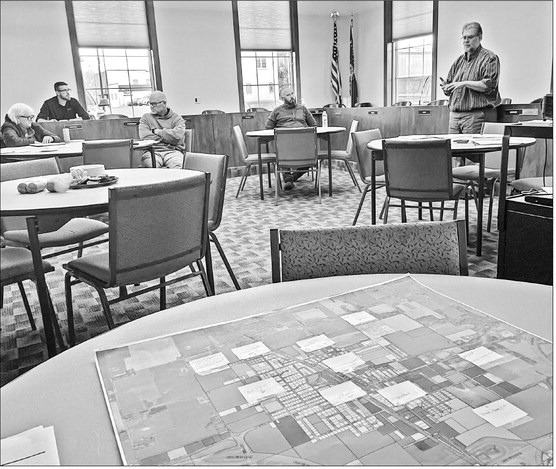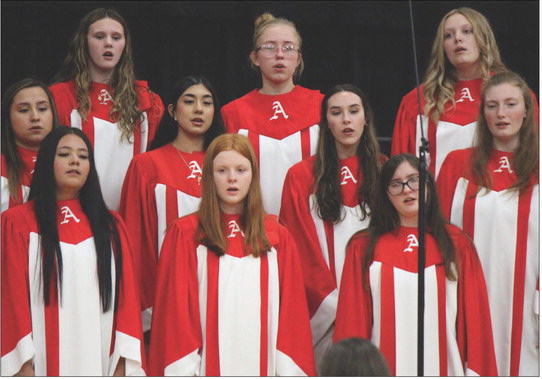Colby K-12 prepares for referendum
By Nathaniel Underwood
The Colby school board took the next steps towards a potential November referendum at a special meeting held this past Monday.
During the meeting, the board narrowed down some of the projects that they would like to see the money of the potential referendum dedicated towards, as well as how they would like the question worded on the November ballot. While small adjustments are likely to be made before the board would possibly approve the final move to go to referendum, they opted for a two-question approach, with the first question currently sitting at $17.7 million and the second at $7.7 million.
Board members utilized data provided both by a community focus group and polling taken via an online survey that was open to the public to help them decide what projects they would like to see covered by the new referendum and the dollar amount.
According to the data collected by SitelogIQ, the facility solutions company that the district chose to aid them through the referendum process, 343 residents of the school district took part in the survey, or 6.8 percent of the 5,048 potential voters. A turnout of 4 percent is typically deemed necessary by the company to obtain statistically significant data.
In that poll, 92 percent of respondents said they would be in favor of a tax-neutral, $16 million referendum. Sixty-two percent stated they would be in favor of a $22 million version and 43 percent would support $26 million.
Infrastructure updates were largely seen as the most necessary, both by the focus group and the polling data, with necessary updates to the mechanical, electrical, and plumbing systems in the middle and high school as well as new roofs on all three schools being the largest cost items.
Other infrastructural items that were deemed high priority included updates to the security camera systems in both build-
See REFERENDUM/ Page 7 Referendum
Continued from page 1
ings and replacing the current generator with a new, upsized model. All of these infrastructure items currently fall under what would be the first question of a potential referendum.
Creating a new addition to the elementary school was just below the infrastructure projects in terms of support on the community survey, averaging a 4.08 out of 5 rating from respondents. It was also one of the top items mentioned by the community task force at an earlier board meeting.
In addition to updating the dining, music and art spaces for the elementary school, the project would also create more classroom space, allowing the district the option to move grade level classes back to their more traditional location. Current plans would see the addition being added to the northeast side of the elementary building.
Returning to a grade configuration more reminiscent of the original was noted as one of the largest priorities by the focus group. The survey data seemed to echo that thought, with only creating and modernizing classrooms and labs for Career and Technical Education (CTE) courses and the infrastructure items rating higher. As it currently stands, the elementary addition would be the sole item under the second question.
There was some concern over whether or not voters, especially those from Dorchester and Unity, would respond to a new addition to the elementary building, given the closure of the schools in those communities, but survey data showed that support for the new building addition was about the same when sorted for responses from individuals from Dorchester.
The board and SitelogIQ also saw the desire for better CTE classrooms, and budgeted for updates to agriculture labs, the greenhouse and business lab in the high school. In preliminary plans, the ag room would be moved to a less used science lab and the business lab placed in the current agriculture classroom.
Other proposed classroom updates include upgrades to the central science rooms in the middle school to more flexible Science, Technology, Engineering,
See REFERENDUM/ Page 13 Referendum
Continued from page 7
Arts and Mathematics (STEAM) classrooms and revamping the special education resource rooms in the elementary.
One of the larger architectural projects is an update to the current high school dining room. The proposal sees the current space opened up and adjoining it with the library across the hallway to make one, larger dining commons space. This would allow the middle school to utilize the space for their own lunch periods, freeing up the middle school gymnasium during those times and creating less wear and tear on the middle school gym floor.
In addition to modernizing and opening up the current dining space, there is also potential for this dining commons to allow access to the central courtyard in the high school, which could lead to better utilization of that space as well. While some library materials would remain in the space, some would likely be moved to a separate section in the library and media center in the middle school.
Creating new, secure entryways for all three buildings, adding additional bathrooms on the north side of the middle school, restructuring the drop off and pick up points at the elementary and making changes to reach ADA compliance in all buildings were also included as architectural projects that the board would like to see done under the new potential referendum.
Discussion of how to best present this referendum to the public was held at Monday’s special meeting, with considerations being given towards the benefits and drawbacks of going with just one referendum question on the November ballot or splitting into two and what items would be on which question. While most board members seemed to agree that splitting the referendum into two questions would be the best option, there were differing opinions on what projects would be covered under each.
“I feel it does two things,” board president Dave Decker said of the current configuration. “It provides an easy explanation for the second question. Plus it also takes a big chunk of the additional spending and puts it in the hands of the voters.”
Another option was presented to the board that saw the big elementary addition put on the first question while items like the dining commons update, new bathrooms in the middle school, and classroom updates were moved to the second question. This would have created a scenario where question one would have been just over $20 million and question two would have been closer to $4.4 million.
“I personally don’t feel like we can afford to not have the elementary addition,” board vice-president Cody Gumz said. “I feel like when we give the option to say no, they might.”
While some on the board felt that this scenario would be safer as it would include their higher priority items on the first question, there was concern over how the second question could be adequately communicated to the public. By packaging less related items on the second question, the board believed that voters may be less inclined to vote for it, and that explaining the need for the elementary addition was a much easier task.
“So that’s really what it comes down to,” superintendent Patrick Galligan said. “Do you think that choice should be the new addition or do you want them to have a choice on most of what we want to do and then an add-on?”
“I’m going back and forth between the two,” Decker said. “But I think a question one with a lesser amount is a ‘yes’ and I do think that it makes it very easy to explain question two with the elementary school being the focus. The benefits of the addition are pretty easy to realize and communicate.”
Other board members echoed similar sentiments, finding that the smaller price tag on the first question and the easier explanation of the second to be more beneficial than putting more of their higher priority items on the second question.
There are still small adjustments to be made to the plan for the referendum, which will once again be discussed at the board’s August meeting, but most of the projects selected and the general numbers given at Monday’s meeting are likely to be on the future referendum should the board approve it.
The move to consider a referendum now was largely due to the fact that the district will have $16 million in debt dropping off this year after they make the final payment on outstanding debt, and many of the infrastructure pieces need attention that goes beyond what would be covered in a normal budget.




